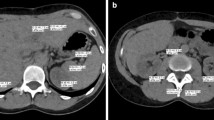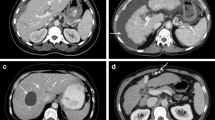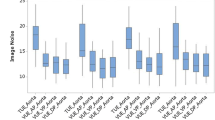Abstract
This study aims to determine whether virtual non-enhanced images derived from dual-energy computed tomography (CT) can replace true non-enhanced images in patients with acute abdomen. Patients with acute abdomen (n = 202) underwent multidetector CT including non-enhanced and contrast-enhanced images obtained at the portal phase using the dual-energy technique. CT attenuation values were measured in abdominal organs. Image quality, noise, artifacts, and acceptability for virtual non-enhanced images compared to true non-enhanced images were rated. Mean sizes of clinically significant stones and mean attenuation values of intraabdominal hemorrhages were compared by means of five-point scales. Effective radiation doses were calculated. Mean CT attenuation values of virtual non-enhanced and true non-enhanced images were similar. Virtual non-enhanced images showed good image quality, mild noise, mild artifacts, and good acceptability compared to true non-enhanced images. A total of 71 clinically significant stones (11 appendicoliths, 33 gallbladder stones, 11 bile duct stones, and 16 urinary stones) and 15 intraabdominal hemorrhages were included in the study. Small stones were detected better on true non-enhanced images than on virtual non-enhanced images. Hemorrhage was similarly detected on both virtual non-enhanced and true non-enhanced images. Mean radiation dose reductions by omitting true non-enhanced images were 33 % in the virtual triple protocol and 47 % in the virtual dual protocol. Image qualities of virtual non-enhanced images are comparable to those of true non-enhanced images. Small stones can be obscured on virtual non-enhanced images. Therefore, tailored application of dual-energy CT is needed for evaluation of patients with acute abdomen.



Similar content being viewed by others
References
Marincek B (2002) Nontraumatic abdominal emergencies: acute abdominal pain: diagnostic strategies. Eur Radiol 12:2136–2150
Rosen MP, Siewert B, Sands DZ, Bromberg R, Edlow J, Raptopoulos V (2003) Value of abdominal CT in the emergency department for patients with abdominal pain. Eur Radiol 13:418–424
Cahir JG, Freeman AH, Courtney HM (2004) Multislice CT of the abdomen. Br J Radiol 77(1):S64–S73
Scheffel H, Stolzmann P, Frauenfelder T, Schertler T, Desbiolles L, Leschka S et al (2007) Dual-energy contrast-enhanced computed tomography for the detection of urinary stone disease. Invest Radiol 42:823–829
Graser A, Johnson TR, Hecht EM, Becker CR, Leidecker C, Staehler M et al (2009) Dual-energy CT in patients suspected of having renal masses: can virtual nonenhanced images replace true nonenhanced images? Radiology 252:433–440
De Cecco CN, Buffa V, Fedeli S, Luzietti M, Vallone A, Ruopoli R et al (2010) Dual-energy CT (DECT) of the liver: conventional versus virtual unenhanced images. Eur Radiol 20:2870–2875
Lee ST et al (2006) Prospective comparison of helical CT of the abdomen and pelvis without and with oral contrast in assessing acute abdominal pain in adult Emergency Department patients. Emerg Radiol 12(4):150–157
Udayasankar UK et al (2009) Acute abdominal pain: value of non-contrast enhanced ultra-low-dose multi-detector row CT as a substitute for abdominal radiographs. Emerg Radiol 16(1):61–70
Huda W (1997) Radiation dosimetry in diagnostic radiology. AJR Am J Roentgenol 169:1487–1488
Ware DE, Huda W, Mergo PJ, Litwiller AL (1999) Radiation effective doses to patients undergoing abdominal CT examinations. Radiology 210:645–650
Kalra MK, Maher MM, Toth TL, Hamberg LM, Blake MA, Shepard JA et al (2004) Strategies for CT radiation dose optimization. Radiology 230:619–628
Borgen L, Kalra MK, Laerum F, Hachette IW, Fredriksson CH, Sandborg M et al (2012) Application of adaptive non-linear 2D and 3D postprocessing filters for reduced dose abdominal CT. Acta Radiol 53:335–342
Ho LM, Yoshizumi TT, Hurwitz LM, Nelson RC, Marin D, Toncheva G et al (2009) Dual-energy versus single-energy MDCT: measurement of radiation dose using adult abdominal imaging protocols. Acad Radiol 16:1400–1407
De Cecco CN, Buffa V, Fedeli S, Vallone A, Ruopoli R, Luzietti M et al (2010) Preliminary experience with abdominal dual-energy CT (DECT): true versus virtual nonenhanced images of the liver. Radiol Med 115:1258–1266
Meinel FG, Bischoff B, Zhang QW, Bamberg F, Reiser MF, Johnson TRC (2012) Metal artifact reduction by dual-energy computed tomography using energetic extrapolation a systematically optimized protocol. Investig Radiol 47:406–414
Sangwaiya MJ, Kalra MK, Sharma A, Halpern EF, Shepard JA, Digumarthy SR (2010) Dual-energy computed tomographic pulmonary angiography: a pilot study to assess the effect on image quality and diagnostic confidence. J Comput Assist Tomogr 34:46–51
Mangold S, Thomas C, Fenchel M, Vuust M, Krauss B, Ketelsen D et al (2012) Virtual nonenhanced dual-energy CT urography with tin-filter technology: determinants of detection of urinary calculi in the renal collecting system. Radiology 264:119–125
Acknowledgments
This work was supported by Wonkwang University in 2012.
Conflict of interest
The authors declare that they have no conflict of interest.
Author information
Authors and Affiliations
Corresponding author
Rights and permissions
About this article
Cite this article
Im, A.L., Lee, Y.H., Bang, D.H. et al. Dual energy CT in patients with acute abdomen; is it possible for virtual non-enhanced images to replace true non-enhanced images?. Emerg Radiol 20, 475–483 (2013). https://doi.org/10.1007/s10140-013-1141-9
Received:
Accepted:
Published:
Issue Date:
DOI: https://doi.org/10.1007/s10140-013-1141-9




